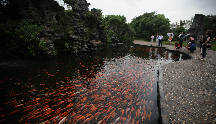Racing the Dragons in Yueyang
Boat Racing
The Dragon Boat Race is most popular in southern China, but its form and content vary from place to place.
The massive participation of competing teams and tens of thousands of cheering spectators make Yueyang the most celebrated of all the boat race venues. The passion of the Yueyang people for the race is summed up in a local saying: "The farm can be neglected, but the Duanwu boat race cannot be left to lose."
The Dragon Boat Race is not like a regular rowing competition. The prow of the boat forms a dragon's head and the stern a dragon's tail. Rowers carry the dragon's head to Qu Yuan Temple for a religious ceremony before they mount it on the prow and launch their craft. After proper rites are performed for the water deities, the dragon boats are seen splashing into the waters in concert. A blast from a cannon signals the start and the boats bolt forward amidst the cheers of the spectators crowding the banks. The competitors display their own colors, each distinguishing hue shared by boat's rowers and their oars. The coxswain stands in the prow, waving a flag and bawling out orders, while the drummer nearby beats the rowing rhythm and keeps up the rowers' spirits. When the boats cross the finish line, the trophy boat will toss three trophies into the water for the boatsmen to catch: a piece of iron, a live fish and a duck, which means every boat must also have a good swimmer who can dive in and retrieve them. The live creatures, each tied with a red ribbon, are doubtless difficult to catch, but the iron trophy sinking to the bottom is no less a challenge to retrieve. The divers create the final dramatic leg of the race for the excited spectators on the banks.
Every year since 1991 the Yueyang International Dragon Boat Festival has drawn scores of competing teams to the annual race on Nanhu Lake.
Yueyang Tower
Dongting Lake broadens toward its eastern banks, where there is a reticulation of waterways and expansive undulating terrain. Yueyang Tower perches right on these shores – mounted on the eastern gate of the Yueyang city wall, and looking down on the lake to the west and the Yangtze River to the north.
The tower was first built as a military parade view point around 220. Its three-storied wooden structure rises up 21.5 meters. The roof is covered in yellow glazed tiles and looks from a distance like an ancient military helmet. The bracket system beneath the helmet roof and the upturned eaves at its four corners are typical of ancient Chinese "flying roof" architecture.
A plaque bearing three Chinese characters meaning "Yueyang Tower" is in the handwriting of celebrated modern Chinese scholar and writer Guo Moruo. Ancient literary giants, including poets Li Bai, Du Fu and Bai Juyi, left behind many masterpieces devoted to Yueyang Tower; the best known of these might be a prose piece written by Song Dynasty thinker, statesman, strategist and writer Fan Zhongyan (989-1052). A line warns, "Be the first to worry about the woes of the people and the last to share their weal," is still widely cited as a moral standard for officials.
A number of exhibits housed in the tower makes the three-story hike more than worthwhile. Inscriptions and couplets written by celebrities from different dynasties can be seen on all the three floors. The first and second floor display screens carved with Fan Zhongyan's prose Yueyang Tower; the one on the first floor is a duplicate of a 19th-century calligraphic work, and the one on the second floor was penned by 18th-century calligrapher Zhang Zhao. The screen on the third floor is carved with Du Fu's poem Ascending Yueyang Tower, in the handwriting of Mao Zedong, whose energetic and unrestrained style also has a broad appeal.
In 1988 the tower was listed as a key cultural relic under national protection by the State Council. Early this year, after reparation work, it was reopened to the public.
Sanzui Pavilion to the north of the tower is one of its subsidiary buildings. It is a nine-meter-high square structure with two floors and two eaves. The pavilion was said to be where Lü Dongbin, one of the Eight Immortals, passed out after an evening's indulgence in drink.
Tips:
Opening Hours:
6:30-19:00 spring and summer; 7:00-18:30 autumn and winter
Entrance fee: RMB 80
Transport: Take city buses No. 1, 2 and 3, or hop on the cruise boat to Dongting Lake that docks at the wharf beneath the tower.
Services
Economy
- Eco-agriculture and Eco-tourism Power Nanchang’s Green Development
- Balance Environmental Protection and Economic Prosperity – Nanchang Looks to European Technology for Green Development
- Sustainable Growth Requires Wiser Energy Use
- Chinese Economy: On the Path of Scientific Development
- China's Economy over the Last Ten Years

